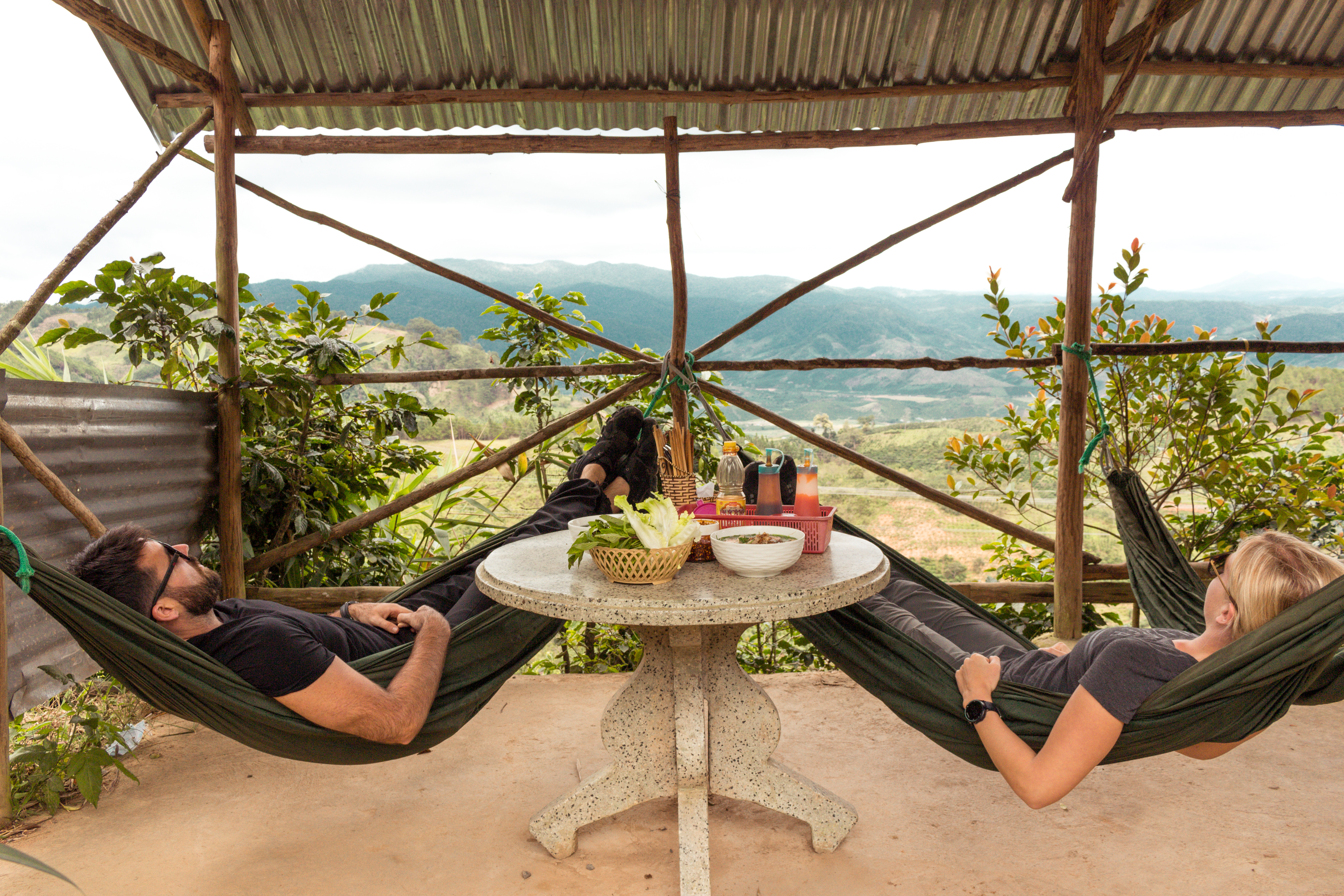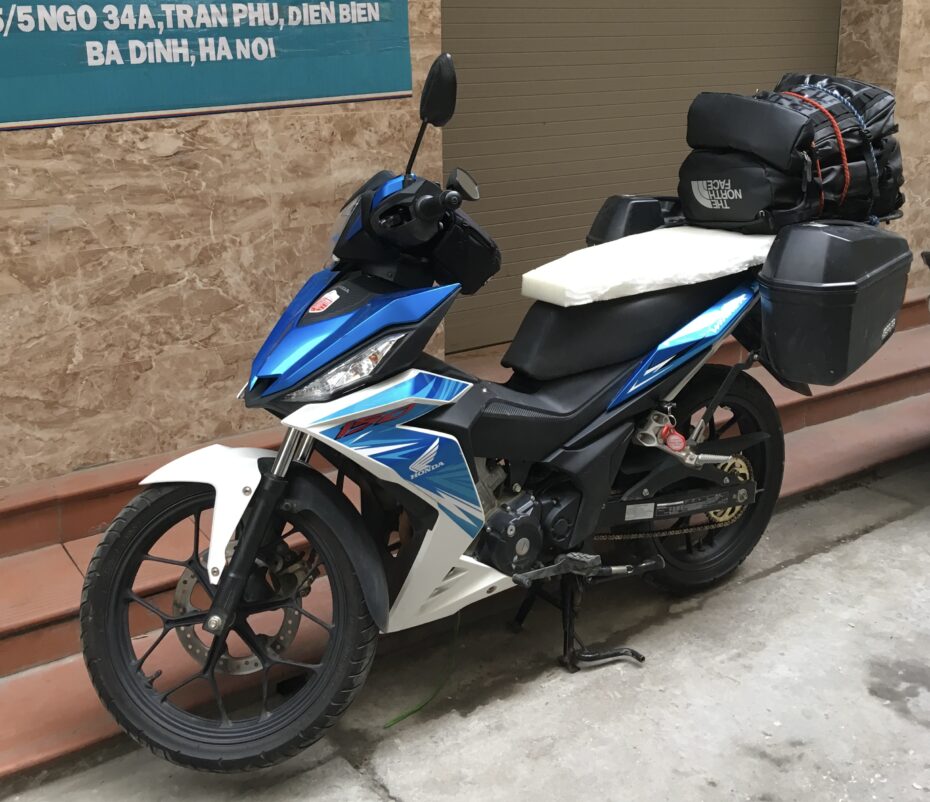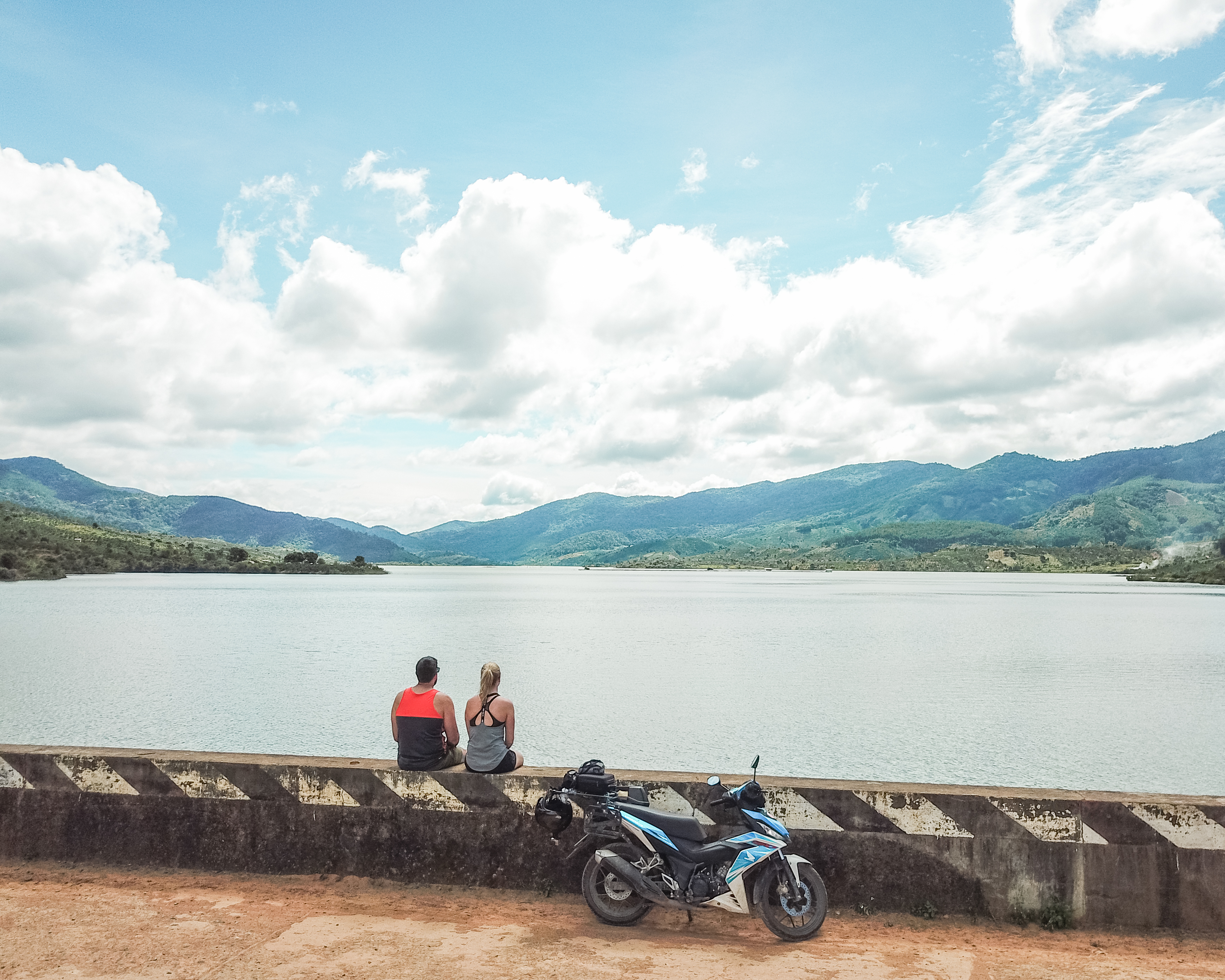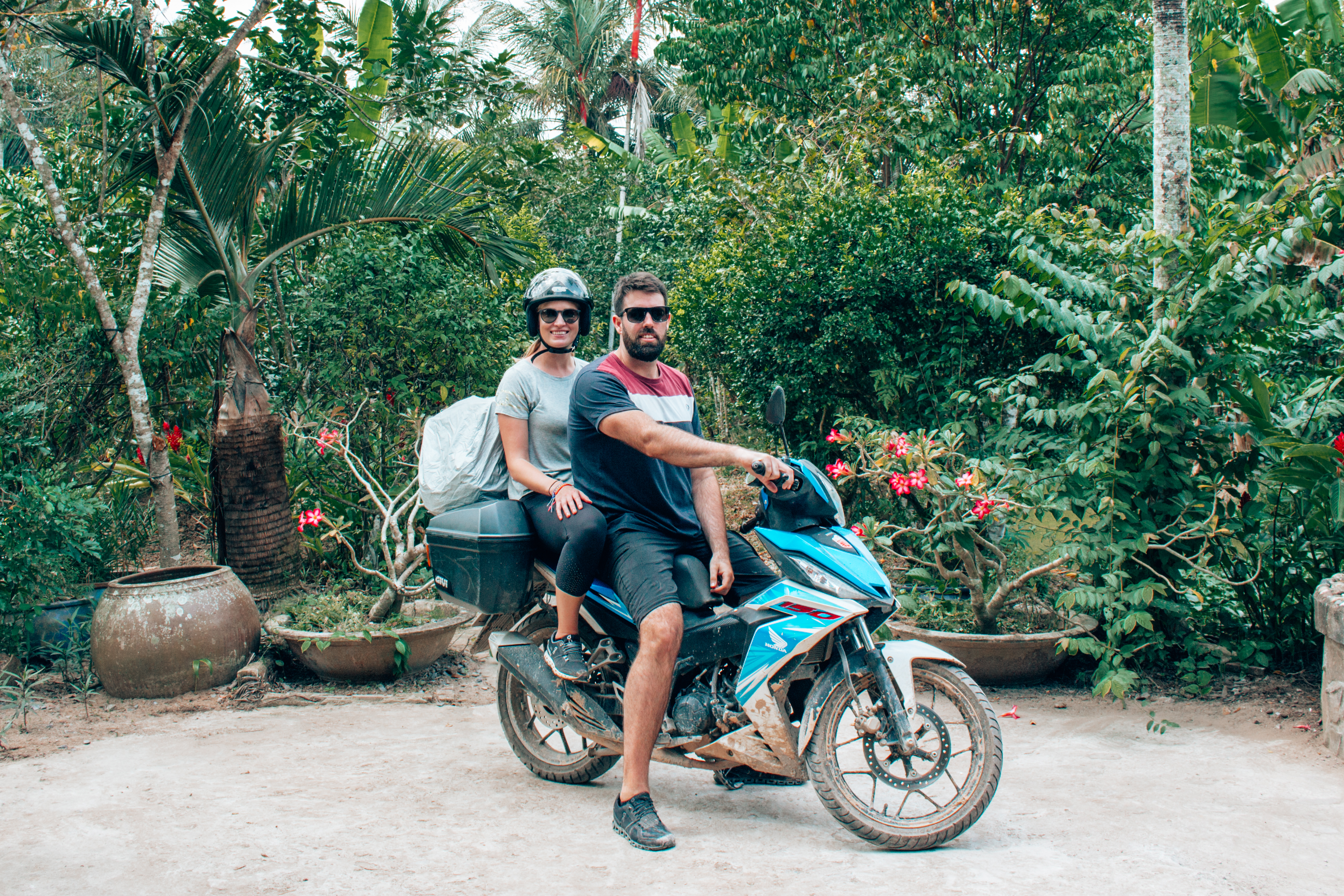Transport in Vietnam
When it comes to transport in Vietnam the options are very limited, particularly given the distance from North to South. Visitors cannot rent cars (you require a local licence) so aside from motorbikes that leaves buses and trains. These are often sleepers, cramped and rarely get off the beaten track. For those of you who know us, you’ll know that we don’t like sticking to schedules, we like to get out of the big cities and we love road trips! For us, travelling isn’t so much about sightseeing in each city, but enjoying the sights on the road at our own pace. After weighing up all the options it seemed like a no-brainer, motorbike seemed to be the only way to truly experience Vietnam. Oh, and it’s been on the top of Brendon’s bucket list since that episode of Top Gear many years ago. Even though it was way out of Hayley’s comfort zone, we couldn’t wait to pack a bag with essentials and get on a bike with nothing but the road ahead of us!
There was a lot that we needed to consider before we got on a bike for three weeks. We’ve outlined many of the decisions we faced when we were planning and also some tips for you along the way.
But first, a piece of advice for you. If you ever get the opportunity to do this trip….DO IT!! If you’re still weighing up whether to take the bike option, you should know that the best parts of our month in Vietnam were spent on the bike visiting the local villages and towns along the way, not to mention some of most epic roads we’ve ever driven. While the big cities have much to offer, we fell more in love with those places that are hard to get to, and it wasn’t until we got to a big city we realised we had gone days without seeing tourists.
First things first…what’s your timeframe?
We spent just over three weeks on the bike from Hanoi to Ho Chi Minh (a month in Vietnam with the time we spent in Hanoi, Bai Tu Long Bay and Phu Quoc). We would recommend nothing shorter than this. We intentionally skipped places due to seasonal weather and we didn’t want our trip to be rushed. We often met bikers who were trying to do the trip in less than three weeks including the northern loop which meant they were up at the crack of dawn for long driving days, and sometimes only a half day at each place. Don’t plan to bike every day as you will need a break every now and again and it’s always nice to stop somewhere to recharge for a couple of days. We met other bikers who had no timeline at all and had taken two weeks to do what others had done in three days…it really depends on what type of trip you want to have. If you want to do a similar trip to us then three weeks was perfect, if you are wanting to see more of the coast or north then we would recommend four weeks. There is also the option of hopping on a train with your bike if you need to save time, we met bikers who took the train from Da Nang to Ninh Binh.

Enjoying a relaxing lunch stop
Secondly, what time of the year are you travelling?
Seasons in Vietnam are something we really struggled with, as there are three distinct areas of the country with very different seasons. We travelled during November and December which meant the North was getting into winter (temperatures get down to single digits and it often snows, this is why we’re saving this for summer), the coast of Central Vietnam was still very much in rainy season and the South was hot and dry. You can guess where we spent most of our time. Do your research on each area before you go but the biggest piece of advice is not book any accommodation in advance. We booked as we went, often the day of or the day before. This meant we could change our plans as we needed, often to suit the weather or to extend places we liked. For us the temperatures were very mild: a bit cooler in the north, a bit hotter in the south but everything in between was very comfortable (except for the rain of course!). The rain did mean that we skipped a lot of the coastal region and headed inland to the mountains.
After talking to locals along the way we’ve decided that April is a perfect time to travel by bike. The north is coming out of winter so temperatures are warmer and a lot more of the country is dry. The only uncomfortable part would be the heat, but once you’re on that bike with the breeze in your face you forget all about it (and your only worry is dusty faces).
Thirdly, who’s driving?
If you’re a couple, do you get one bike or two? For us it was simple. Hayley had never driven a scooter or motorbike before (only ATVs) and Vietnam certainly wasn’t going to be the place for her to learn, especially when we were leaving from Hanoi. If you’re both comfortable driving bikes and are confident with traffic then two would be the way to go (of course if cost isn’t a factor). It means you have more choice on the type of bike because you will have less weight, and you’ll be able to fit your bags comfortably on the back. Even better, find a group of friends and go together (but remember the bigger the group, the slower the trip).
That being said, we really enjoyed being on one bike. Hayley was very comfortable cuddled in behind Brendon smashing snacks every chance she got while Brendon didn’t have to constantly worry about what was happening to Hayley on her own bike around him.
Another option if you are solo or if either of you isn’t comfortable driving is Easy Riders. This is where you are driven around Vietnam on the back of a bike with a local guide. We saw many of these during our trip including couples on two bikes who weren’t comfortable driving themselves.
Next up, the bike itself…
Once you’ve figured out the timeframe, when you’ll be going and how many bikes you’ll need, it’s time to decide if you are renting or buying. This may determine your start and end location, depending on where the rental company is based and also where are you able to buy and sell. There are pros and cons of each, we did extensive research on this and our thoughts are as follows:
TO BUY
PRO: This is the cheaper option. You can pick up a Honda Win for around $250 USD and sell it at the end for much the same or minimal loss. That way your only costs are maintenance costs during the trip.
PRO: You have more freedom as you don’t have an end date, so you can take as long as you need to get from North to South or vice versa.
CON: Buying a second-hand bike means there is a higher chance of something going wrong and it needs fixing along the way. Be prepared to do some minor work before you leave and make sure you have a very flexible schedule. If something goes wrong then you may need to change up your plans a bit while you wait for it to get fixed. The good news is that there are mechanics everywhere and parts are easy to come by, especially for a bike like the Honda Win.
CON: It limits the type of bike you can buy. We would avoid buying a 110cc bike like a Honda Win for two people and your bags. When tackling those mountain passes it will make for a very slow drive. If you’re looking for a bike with a bigger cc then they will be more expensive and harder to find.
TO RENT
PRO: It makes for a worry-free trip. If something goes wrong with the bike then they will fix it or send you a replacement the same or next day. This was the biggest deciding factor for us as we knew we had an end date to our time in Vietnam and couldn’t afford to lose too many days to mechanical issues.
PRO: They are on call 24/7 if something goes wrong. This included Watsapp calling them on one occasion and asking them to translate to a local mechanic that our chain needed tightening (too many Banh Mi in Hoi An…)
PRO: You can give them your bags to send to the destination office. We gave them our large checked in bag and just took our carry on bag with us, it was waiting for us when we dropped off our bike in Ho Chi Minh.
CON: The cost – obviously you can’t sell the bike at the end so you’re making a one-time payment. Our Honda Winner 150cc cost us $350 USD for the three weeks (this would have been the same cost for up to a month, then goes up approximately $10 per day after). If you are renting two bikes, then two Honda Blades would be $500 USD ($250 each).
After weighing all of these up we decided on renting and it was perfect for us. We were given a brand new bike and the biggest trouble we had was the chain popping off once which was tightened straight away and cost $2. However looking back if we could do it all over again we wouldn’t have such a strict end date and keep things more flexible (we already had flights booked to Phu Quoc).

All packed up and ready to hit the road!
Now onto the fun part…choosing your bike!
Depending on whether you rent or buy will determine what type of bike to get, and a lot of thought went into this.
After doing a lot of research on rental bike companies we chose Tigit Motorbikes. They have a great range of high-quality bikes and great service. We highly recommend them and would definitely use them again. Check out their website for everything you need to know. From others we met we heard that Style Motorbikes is also a great company to rent from. The companies will generally have offices in Hanoi and Ho Chi Minh so you can drive one way through Vietnam, but they often have offices elsewhere in case you want a shorter trip.
If you are buying then the common choice is the Honda Win. This bike is the classic Vietnam road trip bike and really looks the part. We admit, our bright blue Honda Winner didn’t really give the look that we were on a road trip through Vietnam, but it was practical, very comfortable and a high-quality manual bike. If you’re buying a bike then chances are you will end up with a Win. The downside here is that it’s a 110cc. The most common choice of bike for long distance travel in Vietnam is between a 110cc and 150cc (the Easy Rider bikes are much bigger). Given the speed limit of 60 km/hr on the country roads then 150cc is the max you will need. If there are two of you then we highly recommend getting a 150cc. We saw some couples on 110cc Honda Blades and not only did the tyres look constantly flat and dangerous when it was loaded up, it would make for a very slow ride particularly through the mountain passes, on the unpaved roads, and when trying to pass trucks and buses. These travellers were up at the crack of dawn to get a head start. The extra power really does make a difference (and it wasn’t until we rented scooters in Pai that we realised how much difference that extra power and a manual bike makes!)
As mentioned Honda doesn’t make the Win anymore so rental companies don’t stock them, however, Detech has started making the new models of the Win and you can rent these from Style Motorbikes. We saw another couple on these and they are really nice bikes!
Bear in mind that the choice of bike will depend on whether you want a manual or automatic. The most common bike we saw for those renting or not comfortable with manuals was the Honda Blade. It’s a 110cc, automatic and perfect size for one person. If you’re after a 150cc then the common choice is a Honda Winner like us or Honda XR (slightly bigger). These are both manuals so make sure you are comfortable driving with a clutch before heading out into the chaotic city streets.
Now you’ve decided on your bike you can start getting ready! We recommend getting to your pick up location (Hanoi or Ho Chi Minh) a couple of days before departing to get things sorted. You’ll be surprised at the amount of time we spent making sure our ride was comfortable.

Enjoying getting off the beaten track
Things to do before getting on the bike:
Head to Tigit straight away to get the paperwork and payment sorted. We were up for a bigger drive the day we left and we didn’t want to spend half the morning sorting administration. This meant we could pick out the bike we wanted and go for a test drive. We also checked out their choice of helmets and knew straight away we wanted to go and buy our own (note that this was at Hanoi, there is a larger range at the Ho Chi Minh office).
Comfortable and safe helmets. You’ll see the locals wear baseball cap looking ones, that is their way of sticking to the law and would do nothing in an accident. Make sure you get one with a visor for keeping dust and rain out of the eyes (this was Brendon’s biggest mistake).
Proper shoes! Don’t wear jandals or sandals, we’ve seen and heard too many horror stories. We were surprised at the number of people we saw wearing these.
A bike outfit, something that is super comfortable that you can throw on for the long driving days. Whatever you wear will get covered in dust, dirt, and soaked in the rain. You will also need to have some protection. We both bought North Face hiking pants (from those “genuine” stores in Hanoi…) They were hardly proper bike pants and we threw these out at the end, but they would do a lot more than cotton floaty pants (yes we saw these being worn by other bikers and also the cuts and grazes underneath). We also had wind jackets and a long sleeve top to wear on the cooler days.
Ponchos. These were lifesavers during the rainy days. We even saw waterproof pants to wear on top and shoe covers. You can never have enough when it’s torrential rain.
Riding gloves. Brendon wore these the whole time. We found these at a Big C supermarket along the way, but you should be able to find these anywhere that sells helmets or accessories.
Face mask. At the end of day one, we thought we had both got a nice tanned face, only to look in a mirror to find dust in every crevice. There’s a reason why the locals all wear them…
Seat sponge. If you followed our stories on Instagram you will know that we went to a mattress store and bought a giant piece of sponge and cut it to the shape of our seat. You may be laughing now but it was so comfortable (a half hour drive without it was worse than an entire day with it) and we had many envious looks when we turned up to Homestays with other bikers. Did we mention that we like to be comfortable while travelling? It was easy to find in Hanoi because the shops are all arranged by trade, we had a quick look around Ho Chi Minh at the end of our trip but unfortunately had no luck.
Side boxes. Tigit had these for our bike and they came in so handy! Again we were the only people we saw with these and everyone asked us where we got them. As you need to bungee cord your bags to the back, it meant that we could keep anything portable in these boxes, including our drone, camera, water bottles, extra layers of clothes, snacks etc. If anything it kept our electronics safer than had they been on the back. Hayley could even get to these while driving which was very handy when there were photo opportunities!
Phone Pouch. Ours strapped to the front of the bike and sat below the speedo which meant it acted like a GPS with Google Maps loaded. Being strapped in two places meant no one could steal it at traffic lights (we’ve heard this is very common for regular phone holders on bikes). There was even room to put our battery pack in so we could keep our phones charged. We bought this from Tigit for $20 and it came waterproof proof cover.
Sim card. These are so cheap that they are worth getting as soon as you arrive. Many of the places we stayed had weak wifi and you don’t want to be caught on the road without being able to contact anyone. We paid $2 for a sim card and $3 got us 7GB of data for the month.
Final tips while you’re on the road:
As you need a local licence in Vietnam to drive (this is the reason you can’t rent cars) then technically your foreign driver’s licence isn’t valid for motorbikes. This means you will need to bribe the police if you’re pulled over. Keep only a maximum of 200k VND in your wallet at all times and keep the rest hidden (this is more than enough for petrol and lunch for the day anyway). If you are pulled over by the police, take the keys out of the bike and hide them (they may try to take your bike) and pretend you don’t speak English. They will try to get you to pay, so once they see you only have $10 or so on you then they will accept it and move on. Hayley wore a travel belt underneath her clothes with extra cash and passports. Luckily we didn’t get pulled over once!
Given the above, if you’re renting the bike then the rental bike company will take your passport or a deposit of around $1’500. If you hand in your passport then make sure you take copies of the photo page and visa page as everywhere you stay will ask for this when you check in. We ended up going for the deposit and this was refunded after two days.
Also, while you are travelling by motorbike then DO NOT DRIVE INTO MUI NE. The police are really corrupt here and they will take your bike off you for at least a week. The fines to bribe your way out of this are upwards of 2 million VND and for us, it just wasn’t worth the risk. If you really want to visit Mui Ne then drive to a town nearby, leave your bike at your hotel and take a bus in. We’ve heard too many stories here and everyone who we met along the way were skipping it.
Highway CT01 is cars and trucks only. DO NOT take this road, you will have a hard time bribing your way out of this one. QL1A is the main highway for motorbikes and are usually very boring drives (this is the road that most buses take). Where possible we used Google Maps to find quieter roads. If you can, take the Ho Chi Minh Highway.
If you’re still reading this then we hope you’re seriously considering this trip and that we’ve helped clarify a few points. This was certainly one of the best trips we’ve done, so much so that we’re already planning to come back for a summer edition! There’s a bit of planning involved but taking everything above into account sure does make for a very comfortable and epic drive.
If you want to see where we stayed and our recommendations along the way then head over to our detailed travel guide!
